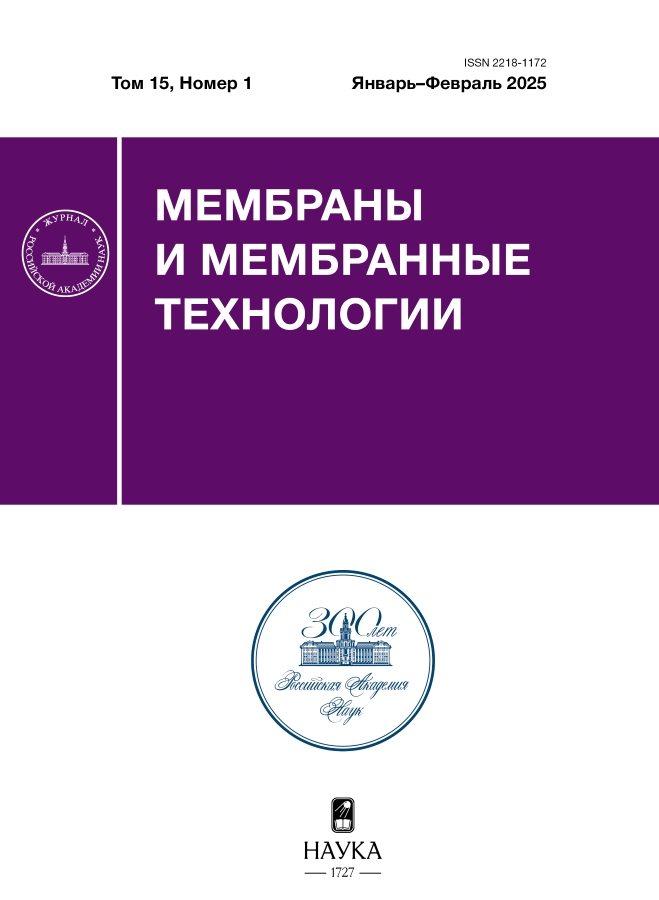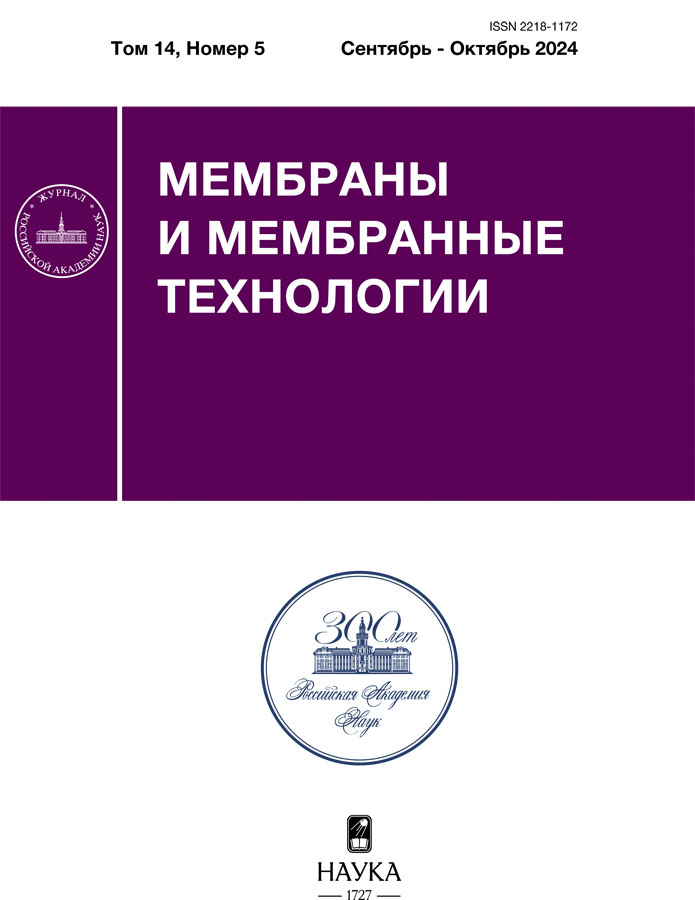Manifestations of Fouling of Heterogeneous Membranes by Wine Components in the Process of their Tartrate Stabilization by Electrodialysis Method
- Authors: Pasechnaya E.L.1, Ponomar M.A.1, Klevtsova A.V.1, Kirichenko K.A.1, Solonchenko K.V.1, Pismenskaya N.D.1
-
Affiliations:
- Kuban State University
- Issue: Vol 14, No 5 (2024)
- Pages: 407-421
- Section: Articles
- URL: https://permmedjournal.ru/2218-1172/article/view/677878
- DOI: https://doi.org/10.31857/S2218117224050067
- EDN: https://elibrary.ru/MXWFUV
- ID: 677878
Cite item
Abstract
Tartrate stabilization of wine components by electrodialysis makes it possible to speed up and automate this process, as well as reduce the loss of valuable components. The widespread introduction of electrodialysis into industrial wine production is hampered due to fouling of ion-exchange membranes with wine components, as well as due to the very limited range of membranes currently used. This study is devoted to a comparative analysis of the properties of relatively inexpensive heterogeneous ion exchange membranes MA-41, MK-40 and AMH-PES, CMH-PES before and after their use in the tartrate stabilization of wine materials by electrodialysis. It has been shown that the mechanisms of fouling and its impact on transport characteristics, as well as on the development of electroconvection and the generation of H+, OH– ions are largely determined by the counterions that are transferred through cation-exchange (transition metal cations) and anion-exchange (carboxylic acid anions) membranes. Membranes MA-41, MK-40 demonstrate higher resistance to fouling during operation in electrodialysis units for less than 15 hours.
Full Text
About the authors
E. L. Pasechnaya
Kuban State University
Email: n_pismen@mail.ru
Russian Federation, Krasnodar, 149, Stavropolskaya St., 350040
M. A. Ponomar
Kuban State University
Email: n_pismen@mail.ru
Russian Federation, Krasnodar, 149, Stavropolskaya St., 350040
A. V. Klevtsova
Kuban State University
Email: n_pismen@mail.ru
Russian Federation, Krasnodar, 149, Stavropolskaya St., 350040
K. A. Kirichenko
Kuban State University
Email: n_pismen@mail.ru
Russian Federation, Krasnodar, 149, Stavropolskaya St., 350040
K. V. Solonchenko
Kuban State University
Email: n_pismen@mail.ru
Russian Federation, Krasnodar, 149, Stavropolskaya St., 350040
N. D. Pismenskaya
Kuban State University
Author for correspondence.
Email: n_pismen@mail.ru
Russian Federation, Krasnodar, 149, Stavropolskaya St., 350040
References
- World Wine Production Outlook // OIV. 2023. 9 pp.
- de Castro M., Baptista J., Matos C., Valente A., Briga-Sá A. // Sci. Total Environ. 2024. V. 930. P. 172383.
- El Rayess Y., Castro-Muñoz R., Cassano A. // Trends Food Sci. Technol. 2024. V.147. P. 104453.
- Cui W., Wang X., Han S., Guo W., Meng N., Li J., Sun B., Zhang X. // Food Chemistry: X. 2024. V. 23. P. 101728
- Granes D., Bouissou D., Lutin F., Moutounet M., Rousseau J. // Bulletin de l’OIV. 2009. V. 82. № 935. P. 57.
- Payan C., Gancel A.-L., Jourdes M., Christmann M., Teissedre P.-L. // OENO One. – 2023. V. 57. № 3. P. 113–126.
- Escudier J., Saint-Pierre B., Batlle J., Moutounet M. Automatic Method and Device for Tartaric Stabilization of Wines, WO9506110. 1995.
- El Rayess Y., Mietton-Peuchot M. // Crit. Rev. Food Sci. Nutr. 2016. V. 56. № 12. P. 2005–2020.
- Vecino X., Reig M., Gibert O., Valderrama C., Cortina J.L. // ACS Sustain. Chem. Eng. 2020. V. 8. № 35. P. 13387–13399.
- Chen M.V. An electrolytic method for tartrate stabilization in Chardonnay winе. 2016. Master’s Theses. California Polytechnic State University, San Luis Obispo. P. 1–74.
- Gnilomedova N., Anikina N., Vesyutova A., Oleinikova V., Gavrish V., Chayka T. // Food Processing: Techniques and Technology. 2022. V. 52. № 3. P. 490–499.
- Benı́tez J.G., Macı́as V.P., Gorostiaga P.S., López R.V., Rodrı́guez L.P. // J. Food. Eng. 2003. V. 58. № 4. P. 373–378.
- Pismenskaya N., Bdiri M., Sarapulova V., Kozmai A., Fouilloux J., Baklouti L., Larchet C., Renard E., Dammak L. // Membranes. 2021. V. 11. № 11. P. 811.
- Jackson R.S. Wine Science: Principles and Applications, Academic Press: UK. 2020.
- Bdiri M., Perreault V., Mikhaylin S., Larchet C., Hellal F., Bazinet L., Dammak L. // Sep. Purif. Technol. 2020. V. 233. P. 115995.
- Fabjanowicz M., Płotka-Wasylka J. // Trends Food Sci. Technol. 2021. V. 112. P. 382–390.
- Zhang X., Kontoudakis N., Wilkes E., Scrimgeour N., Hirlam K., Clark A.C. // Food Chem. 2021. V. 357. P. 129764.
- Ran J., Wu L., He Y., Yang Z., Wang Y., Jiang C., Ge L., Bakangura E., Xu T. // J. Memb. Sci. 2017. V. 522. P. 267–291.
- Akberova E.M., Vasil’eva V.I., Zabolotsky V.I., Novak L. // J. Memb. Sci. 2018. V. 566. P. 317–328.
- Vasil’eva V.I., Zhiltsova A.V., Akberova E.M., Fataeva A.I. // Condensed Matter and Interphases. 2014. V. 16. № 3. P. 257–261.
- Berezina N.P., Kononenko N.A., Dyomina O.A., Gnusin N.P. // Adv. Colloid Interface Sci. 2008. V. 139. № 1-2. P. 3–28.
- Tsygurina K., Pasechnaya E., Chuprynina D., Melkonyan K., Rusinova T., Nikonenko V., Pismenskaya N. // Membranes. 2022. V. 12. №. 12. P. 1187.
- Pasechnaya E.L., Klevtsova A.V., Korshunova A.V., Chuprynina D.A., Pismenskaya N.D. // Membr. Membr. Technol. 2024. V. 6. № 4. P. 273–289.
- Ponomar M., Krasnyuk E., Butylskii D., Nikonenko V., Wang Y., Jiang C., Xu T., Pismenskaya N. // Membranes. 2022. V. 12. № 8. P. 765.
- Lteif R., Dammak L., Larchet C., Auclair B. // Eur. Polym. J. 1999. V. 35. № 7. P. 1187–1195.
- Belashova E.D., Melnik N.A., Pismenskaya N.D., Shevtsova K.A., Nebavsky A.V., Lebedev K.A., Nikonenko V.V. // Electrochimica Acta. 2012. V. 59. P. 412–423.
- Kolbas N.Y. // Scientific notes of the Brest State University named after A. S. Pushkin. 2014. V. 10. P. 30–38.
- Пасечная Е.Л., Пономарь М.А., Клевцова А.В., Коршунова А.В., Сарапулова В.В., Письменская Н.Д. // Мембраны и мембранные технологии. 2024. Т. 14. № 4. с. 317–332.
- Mollaamin F., Mohammadian N.T., Najaflou N., Monajjemi M. // SN Appl. Sci. 2021. V. 3. P. 1–18.
- Helfferich F.G., Dranoff J.S. Ion Exchange, McGraw-Hill: New Yor, 1963.
- Pasechnaya E., Tsygurina K., Ponomar M., Chuprynina D., Nikonenko V., Pismenskaya N. // Membranes. 2023. V. 13. P. 84.
- Perreault V., Sarapulova V., Tsygurina K., Pismenskaya N., Bazinet L. // Membranes. 2021. V. 11. P. 136.
- Bellamy L.J. The Infra-Red Spectra of Complex Molecules, 3rd ed. Springer: Dordrecht, The Netherlands, 1975.
- Tarasevich B.N. Infrared Spectrum of Basic Classes of Organic Compounds. Moscow, 2012.
- Coates J. Interpretation of Infrared Spectra. In Encyclopedia of Analytical Chemistry. John Wiley & Sons, Ltd: Chichester, UK, 2006.
- Ghalloussi R., Garcia-Vasquez W., Chaabane L., Dammak L., Larchet C., Deabate S.V., Nevakshenova E., Nikonenko V., Grande D. // J. Membr. Sci. 2013. V. 436. P. 68.
- Simoes Costa A.M., Costa Sobral M.M., Delgadillo I., Cerdeira A., Rudnitskaya A. // Sensor. Actuat. B-Chemical. 2015. V. 207. P. 1095.
- Garcia-Vasquez W., Ghalloussi R., Dammak L., Larchet C., Nikonenko V., Grande D. // J. Memb. Sci. 2014. V. 452. P. 104–116.
- Scano P. // LWT. 2021. V. 147. P. 111604.
- Newman J.S. Electrochemical Systems. John Wiley & Sons Inc.: Hoboken, New Jersey, 2004.
- Nikonenko V., Nebavsky A., Mareev S., Kovalenko A., Urtenov M., Pourcelly G. // Applied Sciences. 2018. V. 9. № 1. P. 25.
- Rubinstein I., Zaltzman B. // Phys. Rev. Lett. 2015. V. 114. № 11. P. 114502.
- Zabolotsky V.I., Novak L., Kovalenko A.V., Nikonenko V.V., Urtenov M.H., Lebedev K.A., But A Yu. // Petroleum Chemistry. 2017. V. 57. P. 779–789.
- Zabolotsky V.I., Vasil’eva V.I., Lebedev K.A., Akberova E.M., Achoh A.R., Davydov D.V., Loza S.A., Dobryden S.V. // Chem. Eng. Sci. 2024. V.295. P. 120137.
- Rubinstein I., Zaltzman B. // Adv. Colloid. Interface Sci. 2007. V. 134. P. 190–200.
- Pärnamäe R., Mareev S., Nikonenko V., Melnikov S., Sheldeshov N., Zabolotskii V., Hamelers H.V.M. // J. Memb. Sci. 2021. V. 617. P. 118538.
- Sarapulova V., Nevakshenova E., Nebavskaya X., Kozmai A., Aleshkina D., Pourcelly G., Nikonenko V., Pismenskaya N. // J. Memb. Sci. 2018. V. 559. P. 170–182.
- Dressick W.J., Wahl K.J., Bassim N.D., Stroud R.M., Petrovykh D.Y. // Langmuir. – 2012. V. 28. № 45. P. 15831–15843.
- Pismenskaya N., Rybalkina O., Solonchenko K., Butylskii D., Nikonenko V. // Membranes. 2023. V. 13. № 7. P. 647.
Supplementary files


















